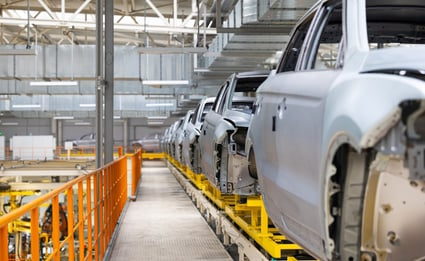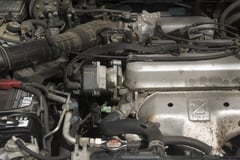What Are the Top 5 Causes of Delay in the Automotive Supply Chain?
Brian Hoey - April 09, 2020

In the US last year, car sales began to slow down after years of historic growth. Whether that’s an anomaly, a real trend caused by millennials eschewing cars, a side-effect of car- and ride-sharing services, or something else entirely, it’s given a lot of automakers pause. After all, when you start hearing from dealerships that they can’t accept any new shipments, there’s a considerable risk that you’ll incur increased storage costs, use up valuable space in your warehouses, and ultimately experience delays in future production runs due to the level of disruption involved in the dip in demand. All this to say nothing of the obvious impact on your sales statistics.
Of course, this is just one potential cause of supply chain delays. There are any number of other issues that can gum up the works of the typical automotive supply chain, and each one has its own set of concerns, warning signs, and contingency plans. Today, we’ll go through the top five such delays in order to give supply chain planners in the auto industry a sense of how best to keep things running smoothly and on-time—in spite of mounting challenges in the global supply chain.
1. Poor Downstream Visibility
You might have expected the first bullet point on this list to be something like natural disasters or trade wars—and don’t worry, we’ll talk about those soon. But first, we’re going to mention something that might seem more mundane: visibility. If your suppliers are going to be late shipping some of the 30,000 parts that go into a typical automobile, how soon are you aware of it? If a shipment has gotten delayed in transit due to a truck breakdown, do you learn about it in real-time? Sure, it might seem like a late shipment of materials is a cause of delay in its own right—but in point of fact a high-visibility planning environment can help you to work around this kind of disruption. To wit, if you see a parts shortage coming a week in advance (through some combination of software integration and advanced predictive analytics) you can find alternative arrangements with other suppliers, or seek out proactive ways to adjust your production ratios to stretch your existing supply of raw materials.
2. Raw Material Shortages
Speaking of raw materials—sometimes it’s not just your supplier that can’t get you the materials you need when you need them. Sometimes, there’s a global shortage of a crucial element like lithium that legitimately makes it harder to get the wide variety of different supplies that go into a completed automobile. This might seem like the type of thing that technology can’t help with—or, at least, not as much as it can help with something like visibility. In reality, though, the two things are closely related. Scarcity favors the proactive. And as raw materials get harder and harder to source, you’ll need ever more robust advanced planning and scheduling workflows in order to project future raw material needs far enough in advance to secure a supply.
3. Trade Wars/Natural Disasters
Trade tensions between the US and China have obviously introduced wrinkles for supply chain managers in the automotive sphere. Now that Brexit is official, the auto industry can expect even more disruption, with any number of major automakers moving their plants out of the UK and into EU countries. And it’s easy to see why a business would make that decision: thorny trade realities can cause delays in sourcing and shipping that can quickly add up to real revenue losses. These kinds of political calculations have always been a part of the calculus for savvy supply chain managers, but in the era of data-driven manufacturing and the impending Fourth Industry Revolution, you can make smarter decisions on this front than ever before. For starters, you can include tariffs and dues in the parameters you use for deciding on the optimal supply, transport, or production network. With that same data, you can use advanced predictive analytics to figure out how trade conditions might impact future price levels for transport, future demand realities, and other important factors. Natural disasters are obviously less predictable, but those same analytics can help you reroute shipments and otherwise pick up the pieces when there's a hurricane or an earthquake that impacts your supply chain.
4. Low Forecast Accuracy
In the preceding sections, you may have gotten the impression that the modern automotive supply chain is finally ripe for analytics integration and, generally speaking, a smarter supply chain. This isn’t an accident. As we approach the era of Industry 4.0, manufacturers of large, complex products have more opportunities than ever to gather data from their own processes, those of their logistics providers, and those of their suppliers. Once that data has been gathered, it can then be leveraged into demand and transport forecasts that are much more accurate than anything that could be reasonably expected from a forecast done by hand or in an Excel spreadsheet. This can be a huge boon, because low-quality forecasts can be a huge cause of delays. Why? Because a huge spike in demand is more likely to take you by surprise if you’re only relying on past orders and gut feelings to schedule your production runs.
5. Quality Control Issues
Okay, we’ve talked about materials shortages, trade wars, and various technological problems. What’s left on the list of unpleasant topics for automakers? That’s right: recalls. If you look at the past few years, any number of automakers have had to recall cars for one reason or another, and the effect is typically that the entire automotive supply chain is sent into disarray as planners seek to figure out complex reverse logistics arrangements and figure out how to store and manage the recalled vehicles. Obviously, the best way to avoid the general disruption—which can include delays on other orders up and downstream—is to avoid being in a recall situation in the first place. Beyond that, however, it becomes a question of visibility again. Do you have the software and analytics integration to come up with reverse logistics scenarios at the drop of a hat? Do you have sufficient visibility into each production run’s bill of materials that you can isolate quality control issues and associate them with the correct vehicles? Can you make snap adjustments as demand realities change in response to the recalls? If you can, great. If not, you may need to do some soul searching regarding the state of your supply chain planning technology.
If you want to learn more get your Guide to Industry 4.0:
LATEST POSTS
- Understand Circular Economy in The Manufacturing Industry
- How Can Industry 4.0 IT Integration Be Achieved Smoothly?
- The Significance of Order Sequencing in Discrete Manufacturing
- How to improve your Supply Chain Management: The Power of Control Towers
- Optimizing Human Resource Scheduling in Manufacturing: A Technological Approach


